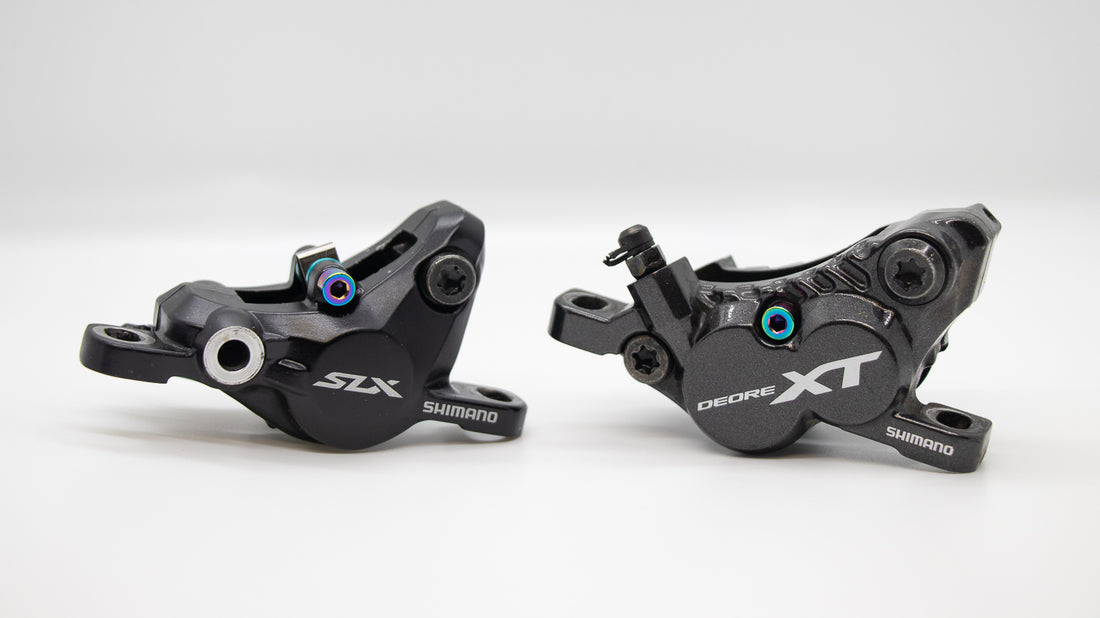As the average suspension travel of a mountain bike has slowly ticked up over the years, other components draping the frame also need to keep up. In the days of an 80mm fork on a hardtail rim brakes could suffice as only the most daring sent those stiff bikes straight down the mountain.
But now, where bike shops carry mostly 140mm+ fully sprung, carbon-fiber bikes, manufacturers have democratized speed and the post-work hour long ride sees faster speeds and more varying terrain than some early cross-country bikes ever did. Not to mention the proliferation of bike parks - now anyone can take a lift to the top and send it all the way down.
With all of this easy speed comes a greater need to arrest that speed. And this must be done over and over without the brakes failing, all while experiencing higher temperatures and higher stress.
Disc brakes are more than up for the task, and varying brake pad compounds and rotor sizes can help with adjusting leverage and preventing fade. The other piece that plays a role in the power equation is the actual brake caliper itself. More specifically, the number of pistons inside the caliper exerting force on the brake pads.
What are Pistons in a Brake Caliper
Inside any brake caliper are sets of pistons. When you squeeze your brake lever at the handlebar, the fluid in your brake hose is pushed through the lines, into the caliper, and against those pistons. Those pistons then extend out of the caliper and clamp the brake pads against the rotor. The harder you squeeze the lever, the more force you are putting into those pistons.
Why Brake Calipers Need More Pistons
Most modern mountain bikes come with brakes that have either 2 or 4 pistons. The simplest way to classify these options would be to say that 2-piston brakes are better for cross-country riding and that 4-piston brakes are better for downhill. Here’s why.
On a single piston brake caliper, your braking surface (i.e. the size of the brake pad) is limited by the size of the piston. Pistons are circular, so if you increase the size of it, it will increase in all directions as it is the diameter that has to increase, versus a single dimension on a x or y axis. The piston can only get so large until it’s too big to fit on the bike and extends off of the surface of the rotor.
If you’re then wanting to increase the size of the braking surface - to get more power - the only option you have is to simply add more pistons. Two pistons next to each other of a similar size means you can extend the size of the brake pad without increasing the diameter of the piston(s) themselves.

The brake pistons leave an imprint on the pad, showing their difference in size and diameter
Technically you could keep adding pistons so you can run larger pads, but if you go too far with it other problems pop up. Yes, there is such a thing as too much power. You want to be able to control your brakes (what everyone calls modulation) versus having them feel like an on and off switch.
While the industry standard is to provide calipers with either 2 or 4 piston brakes, this provides a great balance between a number of factors. Let’s see how this variable in the equation affects how your brakes feel and perform.
2-Piston Brake Calipers
Two piston brake calipers have always been the more common size, until recently. They were used for a variety of riding genres and the bigger four piston calipers were reserved for downhill riders running Shimano Saint.
A 2-piston caliper provides a good compromise between power and weight, as well as a bit more simplicity. Two-piston caliper brakes are usually cheaper to buy, so if you’re building up a bike on a budget, you can save up to $50 or more by going with a 2-piston caliper.

Advantages of 2-Piston Calipers
- Lower Weight: 2-piston calipers are lighter, due to their smaller size. But let’s be honest - who is really going to notice the weight difference?
- Easier to Install/Maintain: The larger 4-piston calipers can have pistons on the same side that extend at uneven rates. On a 2-piston caliper, this isn’t a problem. The smaller caliper (and shorter pad) is also a bit easier to get centered when installing.
- Lower Cost: Relatively speaking, a 2-piston caliper brakeset will cost less than a 4-piston brakeset. For example, Shimano’s 8100 2-piston XT brakeset retails for around $170 a wheel while the 8120 4-piston set is $230.
Disadvantages of 2-Piston Calipers
- Less Power: The smaller pads create less friction on the rotor, and the smaller total surface area of the pistons has less overall power compared to a 4-piston caliper.
- Increased Brake Fade: Less fluid in the caliper, and smaller pads, means the fluid and braking surfaces of a 2-piston caliper heat up faster than a 4-piston setup. Higher temps then result in brake fade.
When to Use a 2-Piston Caliper
A 2-piston caliper is perfect for XC riding and racing and provides plenty of power for the terrain shorter-travel bikes will see. They’re also great for cyclocross bikes, gravel bikes, and commuter bikes, where the braking requirements are lower, and less strenuous, than those of a trail bike.
A 2-piston caliper can also be upgraded with a larger rotor or different pad compound. Making those changes will allow you to get a bit more power out of them before fully committing to replacing the caliper itself.

4-Piston Brake Calipers
As bikes get increased suspension travel and are even more capable, 4-piston calipers are becoming the norm on everything from 130mm trail bikes on up to the ultra-beefy 200mm downhill bikes. Once reserved for only the hucksters, anyone can now benefit from the increased power and modulation a 4-piston caliper provides.

Advantages of 4-Piston Calipers
- More Power: Larger calipers with more pistons call for larger brake pads. This increased surface area helps generate more friction between the pad and the rotor, giving you more power.
- Better Heat Dissipation: The larger surface area of the 4-piston caliper’s components also acts as a larger heat sink. With better management of that heat you’ll experience less brake fade on long, steep descents.
Disadvantages of 4-Piston Calipers
- Increased Weight: While negligible, 4-piston calipers weigh a bit more than their smaller 2-piston relatives. This weight comes from the larger caliper, but also from having to run a larger adapter as 4-piston calipers are usually paired with larger rotors.
- Increased Maintenance: Modern bicycle disc brakes are quite good these days, so this likely won’t be an issue. But if you’ve been running the same brakes for multiple seasons and don’t service them, sticky pistons can cause uneven pad wear and other issues in the larger calipers.
When to Use a 4-Piston Caliper
Sustained and steep descents are what 4-piston brakes are made for. They have the power to slow you down when needed and are less likely to suffer from brake fade when doing so. If you’re riding downhill sections of trail that have higher consequences, 4-piston brakes should be your choice.
They’re also helpful for heavier bikes, like downhill or e-bikes that need a little more power when slowing down all that mass.

Can you Mix 2-Piston and 4-Piston Calipers?
Much like motorcycles and cars, the front brake of your bicycle puts in the most work when it’s time to slow down. If a 2-piston caliper up front isn’t cutting it because it has been left to bear most of the load, larger brakes can be fitted on the front to help re-balance your overall brake setup.
Running a 4-piston caliper on the front and a 2-piston caliper on the rear will give you the power you need up front with the lighter touch you need out back. Modern bike brakes can lock up the rear tires with little effort, so a 2-piston caliper in the back helps keep the unwanted skids under control.
Is there a single piston brake caliper?
Yes, cable disc brakes have a single-piston and work much like a traditional car’s brakes where there are only pistons on one side. A car’s brakes are a bit more sophisticated, but on a single-piston caliper the piston pushes the brake pad against the rotor and this causes the rotor to flex into the pad on the other side. They’re a bit more finicky than a hydraulic brake and require periodic adjustments, as the calipers aren’t self-adjusting to compensate for pad wear.
Choosing Between 2-Piston and 4-Piston Calipers
There are a number of factors that play into the types of brakes you run and how many pistons to go with. Beyond the advantages and disadvantages highlighted above, brakes from different manufacturers also have their own set of unique characteristics.
A 2-piston caliper from Magura will feel different than one from Shimano, and you may find that a simple brand change will yield the results you want. At the end of the day though there’s no replacement for displacement and a larger caliper will get you more power when you need to drop the anchors.
If you’re experiencing brake fade or have to drag your brakes the whole way down the hill to keep from blowing a corner, upgrading to a 4-piston caliper will work wonders. You can also further customize how your brakes feel by changing the pad compound or upgrading to a larger rotor.


2 comments
Lots of useful information….if I upgrade my rotor in the front if my e bike from 160mm to 180mm is that a straight exchange? Will I have to change the caliper as well?
Nice article but I noticed you don’t include a discussion of the hydraulic principals.
With a 4-piston caliper you get more clamping pressure for the same amount of lever pressure, albeit with slightly more lever travel. That, combined with increased pad real estate gives you the increased stopping power. The increased lever travel is usually not very noticeable. It’s all about PSI working on a larger area of piston surface.
As for brake-fade. Brake fade is mostly due to pad composition combined with heat, not piston area. When stopping from a high speed or controlling speed on a long downhill stretch cheap organic pads will glaze over and reduce stopping power, usually permanently until the pads are maintained or replaced. Metallic pads are one solution to this but high-quality organics can work very well too.